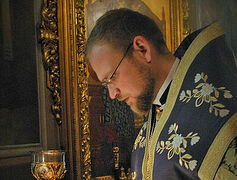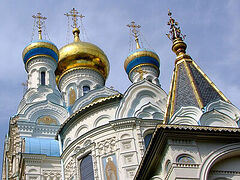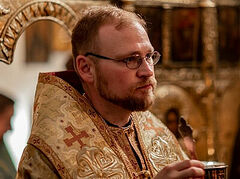Fr. Vaclav serves in the famous Cathedral of Sts. Cyril and Methodius in Prague, helping its rector. He converted to the faith through his passion for archeology, became the first foreign priest in the history of Cyprus, and over the years of his ministry he concluded that only good should be seen in every human being. In Part 1, Fr. Vaclav talks about the complex development of Orthodoxy in the lands of the Czech Republic and Slovakia, Czech atheism, and conciliarity as the basis of the Church.
—Christ is Risen!
—In Truth He is Risen!
—Fr. Vaclav, please tell us how you converted to the faith.
—My path to the faith was thorny. My father was a Czech who only had faith in his heart, but did not go to church. My mother was Orthodox, originally from Siberia in Russia. She was a very sensitive person. It was her sensitivity, reflected in my upbringing, that played a huge role in my openness to God. I inherited rationality and pragmatism from my father and emotionality from my mother. As a priest, today I see many mixed marriages between Czechs and Russians or Ukrainians, and I often recall my childhood when different mentalities were mixed in such marriages: the cold, down-to-earth pragmatism of Czechs and the emotional openness of the Eastern Slavs. For a theologian, a combination of emotions and rationality is vital, and it was providential that I received such a valuable experience from my dissimilar parents.
When I was a child, my parents emigrated to Australia. We returned to Communist Czechoslovakia, where for several years I had to face a number of difficulties because I was perceived as an immigrant child. I couldn’t fit into my environment, which forced me to withdraw into myself and “go into internal emigration.” Seeking solace, I became interested in archeology. In my fantasies I traveled the world, since after returning to Czechoslovakia our family didn’t have such freedom of movement as before. While studying archeology, I came to the conclusion that archeology is about religion, and thus I developed a new interest: theology.
 In Cyprus Under the Communist regime I didn’t think of seriously studying theology. One day my mother went to a resort where she met a former White Army soldier who had become an Orthodox priest. They talked a lot. Having learned about my interests, he recommended that my mother enroll me in the Theological Department of University of Presov in Slovakia.
In Cyprus Under the Communist regime I didn’t think of seriously studying theology. One day my mother went to a resort where she met a former White Army soldier who had become an Orthodox priest. They talked a lot. Having learned about my interests, he recommended that my mother enroll me in the Theological Department of University of Presov in Slovakia.
And so I did. I went to Presov and was well received there. Soon after my arrival, the Velvet Revolution broke out in Slovakia, and after studying for two years I left for Australia where I studied archeology and Orthodox theology. I also spent a year on Mt. Athos where I was fortunate enough to meet Elder Paisios the Athonite.
After some time in Australia, a professor from Presov approached me and suggested that I return and teach Byzantine Studies at the Theological Department. After that I became a priest and started serving in Olomouc.
—Where did you start serving and where do you serve now?
—I started my ministry in Olomouc in Moravia, where Sts. Cyril and Methodius preached. We had very few believers there, and I fought for every human soul, convincing them to go to church. I had to adapt my preaching to an environment of total atheism. On the way to the church, Fr. Petr Novak and I were pelted with eggs from the windows of high-rise apartment blocks because residents didn’t like our cassocks. It was a hard time.
Later, since I was teaching in Presov, I was sent to a parish in the village of Markovce in eastern Slovakia, where most believers were from a Roma background. I quickly found a common language with them and learned a valuable lesson: people always feel what your heart is, and a priest cannot become what he really is not.
Then I moved with my family to Cyprus, where for five years I served as a priest in the diocese of the outstanding Metropolitan Isaiah of Tamassos and Orinis. I was probably the first foreigner in the country’s history to serve at a traditional Cypriot mountain parish. I learned a lot there, especially patience, because I understood that Orthodoxy is about community. The parish made up one large family there, where everyone was connected with each other, and the priest was at the center of the community. It was a shock because I was used to being closed and isolated, carrying out my priestly ministry in Slovakia. But in Cyprus I realized that Orthodoxy cannot exist outside a specific community.
From Cyprus I returned to Prague, where for five years I have served in the Cathedral of Sts. Cyril and Methodius. My experience in Prague is interesting, but the main problem I am facing is the difficulty of teaching people to live in community: conciliarly, and not separately.
Interest in Orthodoxy isn’t an intellectual quest; rather, it’s life in a community, which, unfortunately, few people understand here.
The complex history of Orthodoxy in Czechia and Slovakia
— In Russia, little is known about what is happening in the life of the Church of the Czech Lands. It is interesting that Sts. Cyril and Methodius came to these lands to preach Christianity, and through their labors a diocese appeared. But today Czechia, at least culturally, is a Catholic country. What happened? And what are the main milestones in the life of Orthodoxy in these lands from the time of Sts. Cyril and Methodius up to the present day?
—Bohemia, Moravia, Slovakia are geographically and culturally located in Central Europe. Christianity began to emerge in this region as part of individual missionary efforts even before 863. St. Rastislav, Prince of Great Moravia, understood that his subjects needed a form of Christianity that could correspond to the local culture and peoples. He wanted the Byzantine Emperor to send enlighteners from Byzantium who could work with the local culture. So in 863 Sts. Cyril and Methodius arrived in Great Moravia and began their mission. Their preaching was very effective because up to the eleventh century the Slavonic liturgical tradition developed quite actively here.
 (The Prague Cathedral of Sts. Cyril and Methodius—the principal church of the Church of the Czech Lands and Slovakia
(The Prague Cathedral of Sts. Cyril and Methodius—the principal church of the Church of the Czech Lands and Slovakia
However, internal conflicts forced local princes to fight against each other and use Latin (German and Frankish) support. Rastislav was overthrown. Local rulers, striving to realize their political goals and retain power, ignored their own Slavonic liturgical and jurisdictional orientation. The country fell into the sphere of influence of Germany, the Latin jurisdiction and German tradition.
This is an illustrative example of how the striving for power of a small group of people leads to the elimination of the (primarily spiritual) sovereignty of their own nation. Later, the Hussite movement emerged in Bohemia, which criticized the Roman Catholic Church. Czech independence ended after the Battle of White Mountain in 1620, while Slovakia was under Hungarian rule for a long time. In Eastern Slovakia, as in Transcarpathian Rus’, the tradition of Sts. Cyril and Methodius was preserved to a greater or lesser extent, while in Bohemia it was eradicated around the sixteenth century.
Fighters for national revival in Bohemia also turned to the legacy of Sts. Cyril and Methodius. In intellectual circles the Catholic Church in Bohemia was regarded as an instrument of Germanization by Austria-Hungary. But in the nineteenth century this didn’t lead to an interest in Orthodoxy.
Gaining independence after 1918, President Tomas Masaryk regarded Orthodoxy as a suspicious and irrational faith and preferred some form of Protestant humanism. In Eastern Slovakia, Eastern rite parishes were under the full control of the Greek Catholic (Uniate) Church. There was nothing to build the Orthodox Church on.
—Nevertheless, a whole Local Church appeared. Historically the Czechoslovak Orthodox Church was under the jurisdiction of the Serbian Orthodox Church and the Moscow Patriarchate. Can we say that today the bond between these Local Churches is strong? Against the background of political events, is there tension in relations with the Russian Orthodox Church?
—After the First World War, there was practically no Orthodoxy in Czechia and Moravia, with a few exceptions. In Slovakia, Eastern Christianity existed in the Uniate Church. The union with Rome was backed by the Austrian Government and aristocracy. Orthodoxy couldn’t develop because it threatened believers with economic and cultural isolation. After WWI, some parishes in Eastern Slovakia separated from the Uniate Church and began the revival of Orthodoxy, which was backed by emigrants arriving from the former Russian Empire. But in many cases those parishes and people didn’t separate from the Uniates for the sake of Orthodoxy—this was for economic, personal, national and other reasons.
This gave rise to a number of problems. In Bohemia and Moravia, Matej Pavlik, a former Catholic priest, after WWI stood at the origins of a new Church, which arose from Catholic communities. Those communities were divided into Orthodox and Protestants.
Internal quarrels, discussions and hatred between community leaders weakened the potential of Orthodoxy. Matej Pavlik, like others, knew little about Orthodox theology and “played the national card”, believing that Orthodoxy is the “natural” religion of the Czechs and Moravians. Other missionaries began to open parishes of one Orthodox jurisdiction to the detriment of another.
 Hieromartyr Gorazd (Pavlik) The situation was complicated by the arrival of emigrants from the Russian Empire after the Revolution. There was controversy over jurisdictions, which one they should belong to. Real contact for Russian emigrants with the Russian Church were impossible due to difficult post-revolutionary circumstances. The controversy was smoothed over by real pastoral work. Pavlik was consecrated a bishop, and the Church came under the Serbian jurisdiction. The popularity of Orthodoxy at that time was also caused by the post-war national revival. Pavlik took the name Gorazd [in monasticism and/or as a bishop.—Ed.] and by building the Church under the SOC he was actually building his own understanding of Orthodoxy. This led to his martyrdom at the hands of Germans during World War II. Bishop Gorazd also laid the foundations of our liturgical tradition.
Hieromartyr Gorazd (Pavlik) The situation was complicated by the arrival of emigrants from the Russian Empire after the Revolution. There was controversy over jurisdictions, which one they should belong to. Real contact for Russian emigrants with the Russian Church were impossible due to difficult post-revolutionary circumstances. The controversy was smoothed over by real pastoral work. Pavlik was consecrated a bishop, and the Church came under the Serbian jurisdiction. The popularity of Orthodoxy at that time was also caused by the post-war national revival. Pavlik took the name Gorazd [in monasticism and/or as a bishop.—Ed.] and by building the Church under the SOC he was actually building his own understanding of Orthodoxy. This led to his martyrdom at the hands of Germans during World War II. Bishop Gorazd also laid the foundations of our liturgical tradition.
The Orthodox Church gained recognition for its role in WWII, but its development was impeded by the coming of the Communists to power. The Communists wanted to take advantage of people’s suspicions of the Roman Catholic Church to undermine its influence. In 1950, the so-called “Council of Presov” was held. Its task was to unite the Greek Catholics with the Orthodox Church. This caused many years of disagreement between the Orthodox Church and the Greek Catholic Church. The Orthodox Church wasn’t responsible for convening that “Council”, because not a single Orthodox priest was present there. The disputes were resolved in 1989, after the Velvet Revolution: the majority of “Orthodox” returned to the Uniates, and the rest became the backbone of Orthodoxy in what is now Eastern Slovakia. An influx of believers from the Greek Catholic Church had triggered the rapid development of the Orthodox Church. The next key moment was the granting of autocephaly by the Russian Orthodox Church in 1951 and the arrival of Metropolitan Eleutherius (Vorontsov). Believers from Russia, Ukraine and Belarus showed vivid evidence of sincere faith by their confession of it in the Soviet era, and Vladyka Eleutherius had been imprisoned by the Communists. The Orthodox Church continues to fight the stigma caused by the experience of the Communist past. Communism largely stopped the development of Orthodoxy in our lands. The Communists tried to convince the Orthodox Church leaders of their own significant role for Czechia. Then opportunists, adventurers, simply weirdos, and people associated with the State authorities became clergy. But good, pious priests also appeared.
What about today? On Czech atheism and other problems
After the 1989 Revolution, a multitude of problems accumulated over the past decades were suddenly revealed. It turned out that no one was interested in Bishop Gorazd’s national idea and the connection of Orthodoxy with the Czech, Moravian or Slovak people. In addition, the return of believers to the Uniate Church and other problems that were revealed showed that the Church had to find a new key to development. Then the Patriarchate of Constantinople granted us autocephaly again.
The Communists destroyed Church life from the point of view of conciliarity, Orthodox society. However, it can be said that at least Orthodox education flourished during the Communist era and, paradoxically, perhaps much more than it does now.
Unfortunately, the Orthodox mission brought and still brings to the lands of Central Europe elements of an individualistic approach and a lack of understanding of the importance of community in the life of the Church. Historically, this was also traced in relation to Russia and Ukraine. There are indeed many opinions and extremes here. Some perceive Russians, Ukrainians and Belarusians as Slavs who are our brothers; others perceive these regions as a political threat; and others as territories to which the Czech Republic no longer belongs. This is also due to the traditional splitting of the consciousness of local “revivalists” and Panslavists, who declare Slavic unity but ultimately come to the conclusion that the Czech Slavs are at a higher cultural level than the others.
This also affects the Orthodox mission. Criticism of Orthodoxy is sometimes primitively associated with political criticism. There is also an artificial division into “West” and “East”. However, modern historiography demonstrates that the division into “Western” and “Eastern” cultures is a black and white understanding of life and historical processes. In fact, one cannot talk about the existence of “Eastern” or “Western” Christian culture, but rather about the forms of regional influence of Christianity on local cultures. For example, the Portuguese Church tradition has much in common with the Church culture of Greece and other countries. We cannot and shouldn’t talk about a confrontation between East and West.
Such fragmentation of views, typical for the Czech environment, turns out to be absolutely destructive for the Orthodox mission, especially now, when emigration to us from Ukraine, Russia and Transcarpathia is quite active. The Orthodox Church in Czechia didn’t learn from the problems of the First Republic [the republican regime in France from the abolition of the monarchy in 1792 until Napoleon's accession as Emperor in 1804.—Trans.], and the imposition of its own views at any cost leads to nothing. Moreover, we should promote major Christian values based on tolerance, mutual respect and dialogue, striving to understand those we speak with. If the Orthodox want to survive in an atheistic environment, they must stop quarreling among themselves and start at least listening to their opponents. Thus, the problem in the Czech lands is not in which jurisdiction it is better or worse, nor in whether the focus should be East or West, but that the foundations of the gospel as conciliarity haven’t taken root here. There is no Church without conciliarity. The relative calm provided by governmental restitutions granted after 1989 has also failed to help the Church really explore modern forms of fundraising.




